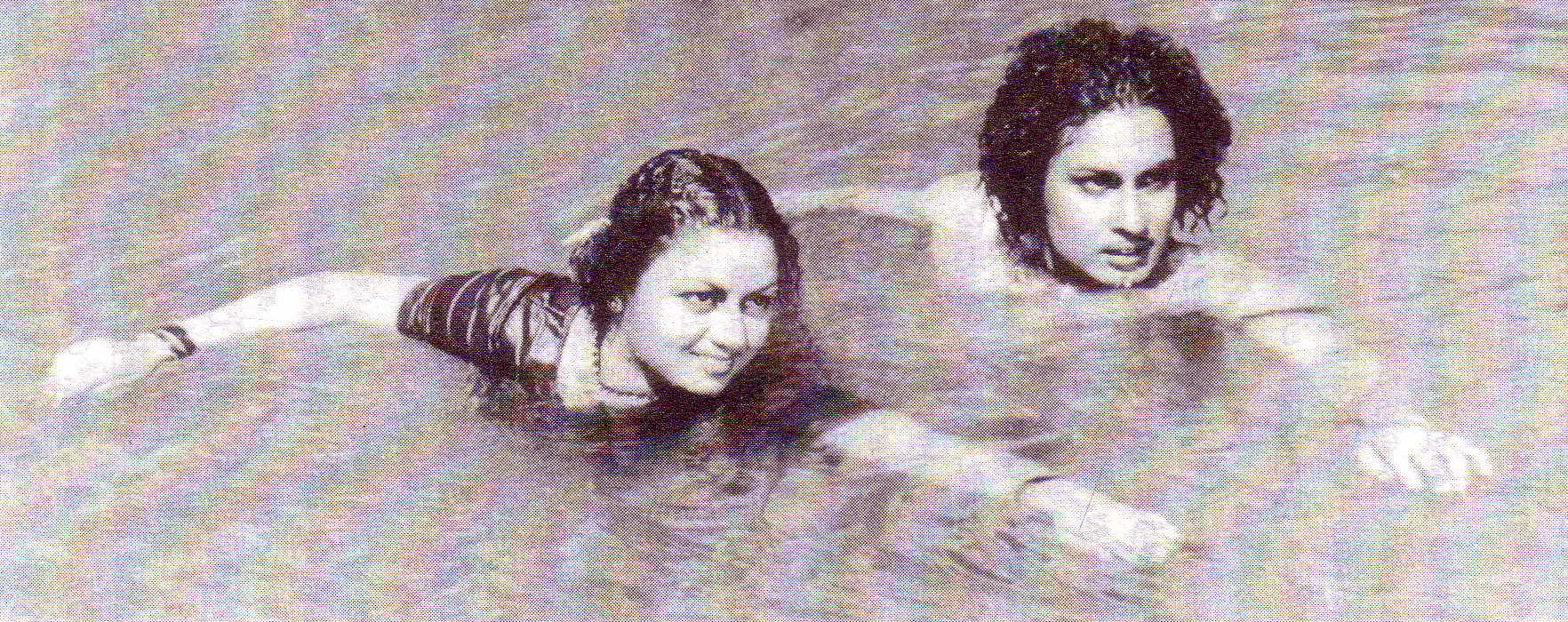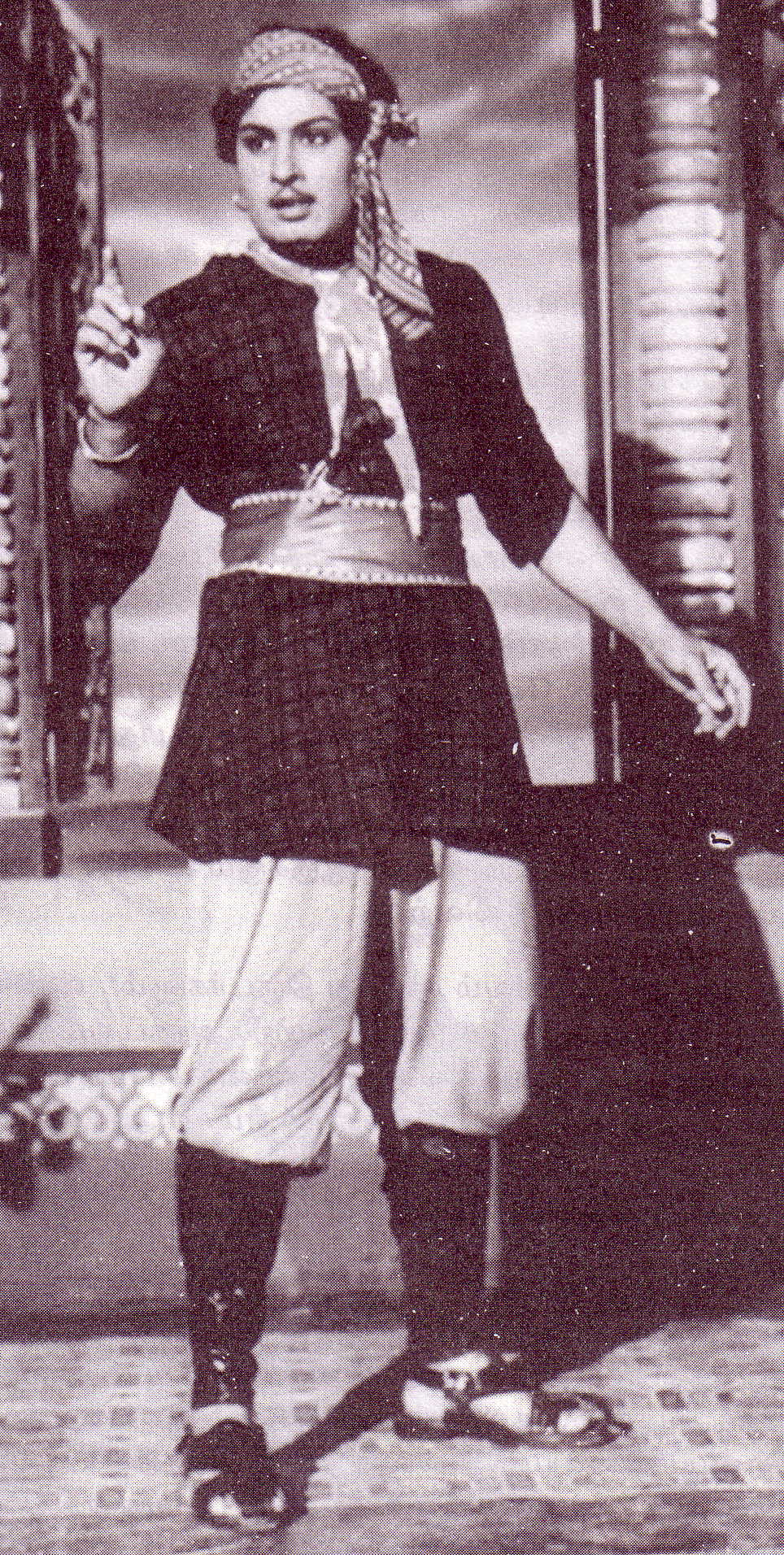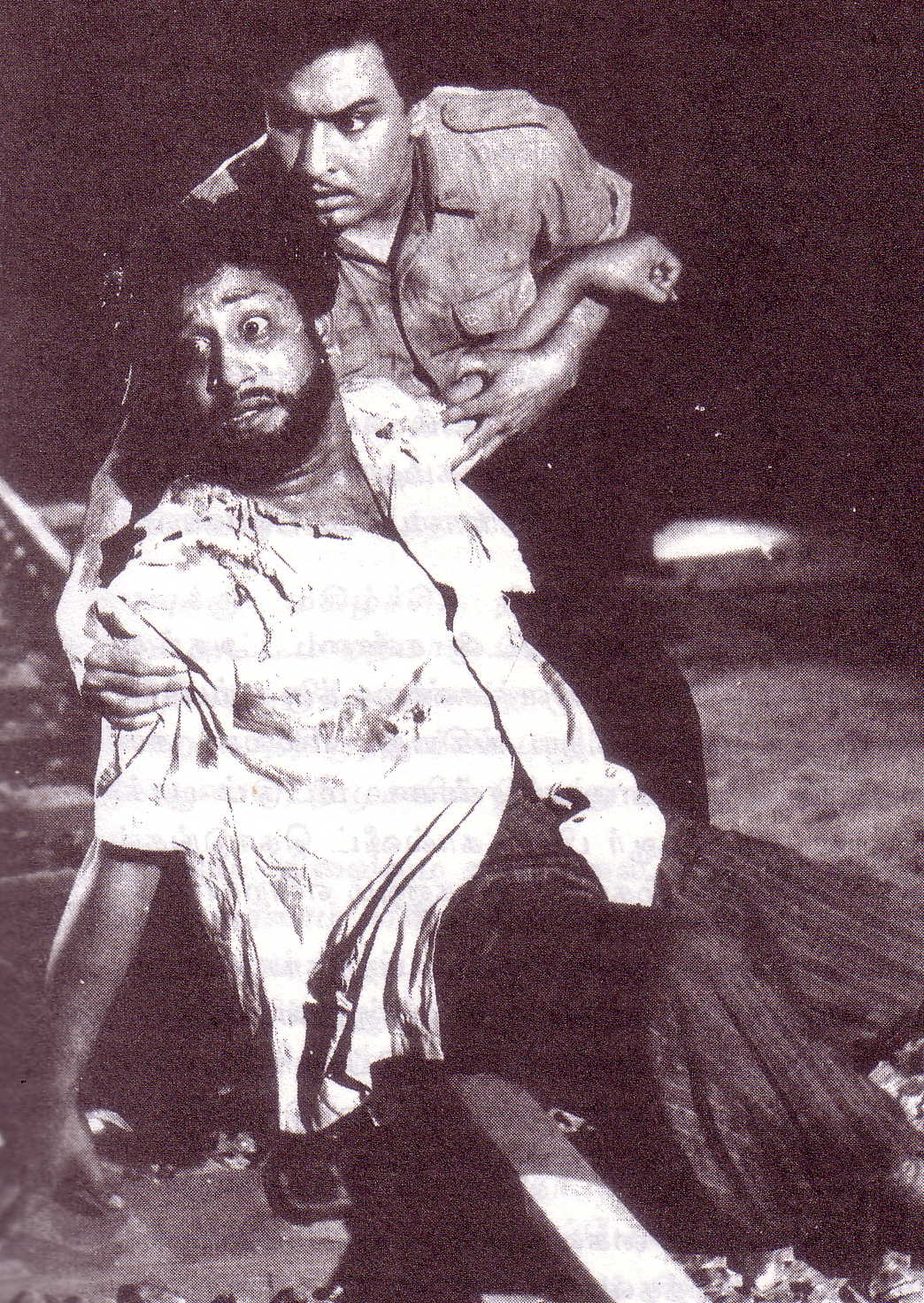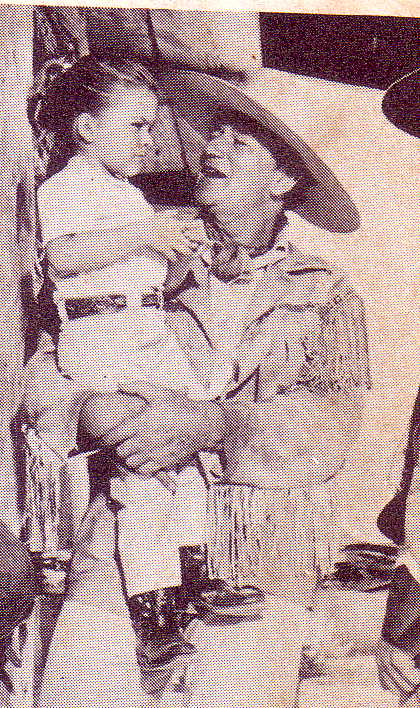by Sachi Sri Kantha, September 27, 2013
Mythologies in the movies of India and Hollywood
There is a derisive Tamil idiom which pokes fun at half-baked scholarship. It is, ‘Kundu chattikul irunthu kuthirai ootuvathu pola’ [translation: Like horse riding within a hollow pot]. One cannot ride a horse with the narrow confines of space (i.e., knowledge), isn’t it? In the past, scholarship on MGR’s movies had suffered from the half-baked scholars among Tamils, who had a ‘Marxist-socialist-progressive’ attitude. M.S.S. Pandian and K. Sivathamby were two of them. Even American academics like Robert Hardgrave Jr and Eric Barnouw somewhat had failed in comparing MGR’s movie career with that of his contemporary John Wayne, the Hollywood hero. This was one of the reasons, why I began writing this series.
Another reason was that, this is the centenary year of Indian movies. Rajah Harischandra (King Harischandra), produced by Dhundiraj Govind Phalke (1870-1944) aka Dadasaheb Phalke with a capital of Indian rupees 15,000 was released in 1913 as a full length feature film at the Coronation Cinema in Bombay. The movie was 3,700 feet ong (roughly one hour of projection time, at a projection speed of about 3,000-4,000 feet per hour). Raja Harischandra was a popular Hindu mythological story from Mahabharata epic, and Phalke was backed by a Nadkarni, a Bombay dealer in photographic goods. Even if I cannot cover the entire history of Indian movies in many languages for deficit in knowledge and lack of resources, I thought of writing a biography of MGR, one of the pivotal figure in Tamil movies and politics, based on my collections.
Thus, in this part, I provide a comparison on the careers of MGR and John Wayne (two adept horse riders in movie history!), and this had not been attempted by any previous analysts who had studied MGR’s movie career. Hindu mythology was the mine source for Indian movies. Similarly, Hollywood movies also depended on the mythology of immigrant American nation, which can be tagged as ‘Westerns’ (derisively tagged as ‘horse operas’). Film historian Leslie Halliwell identifies the following special characteristics of ‘Westerns’: (1) Westerns have been with us almost as long as the cinema itself. (2) It is natural enough that almost all westerns should have come from America. (3) The attractions of western stories included natural settings, cheapness of production, ready- made plots capable of infinite variation, and a general air of tough simplicity which was saleable the world over. Like Indian mythology plots enhanced by songs, even Hollywood westerns had a singing cowboy character in 1940s and few performers like Gene Autry (1907-1998) and Roy Rogers (1911-1998) became identified with this character.
Movies of MGR and John Wayne in 1950s decade
In the previous part, I provided a career comparison table of MGR and John Wayne. Let me elaborate on this comparison. In their movie careers, the total number of movies starred by MGR (between 1936 and 1978) and John Wayne (between 1928 and 1976) were 136 and 152 respectively. In the 1950s decade, both featured in almost equal number of movies; MGR in 25, and John Wayne in 22. With a few notable exceptions, both chose the type of vehicle in which they had expertise and had framed their minds to gain fame. John Wayne focused on ‘American historical adventures, including Westerns’ and MGR’s focus was on ‘Tamil historical costume adventures’ [the so-called ‘Raja-Rani kathai (King-Queen stories)].
The name list of 25 movies, their release dates, screens writers and directors details (in chronological sequence) of MGR movies are given below. I provide appropriate English translations of the Tamil movie titles to the best of my knowledge. Shared credits for either script writing or direction are indicated by hyphen between the names.
Maruthanattu Ilavarasi (Princess from Maruthaland) April 1950, M.Karunanidhi, A.Kasilingam.
Manthiri Kumari (Minister’s Daughter) June 1950, (adoption from ancient Tamil-Buddhist epic Kundalakesi story) M. Karunanidhi, Ellis Dungan -T.R.Sundaram.
Marma Yogi (The Secret Mystic) Feb 1951, (a mix of British novelist Marrie Correlli 1886 novel Vendetta and Robin Hood legend) A.S.A.Sami, K.Ramnath.
Sarvadhikari (The Dictator) Sept. 1951, A.V.P.Asaithambi, T.R.Sundaram.
Andaman Kaithi (Prisoner in Andaman Island) March 1952, Ku.Sa.Krishnamoorthy, V. Krishnan.
Kumari (Young Girl) April 1952, Ku.Sa. Krishnamoorthy, R.Padmanaban
Yen Thangai (My Younger Sister) May 1952, T.S.Nadarajan-K.M.Govindarajan, C.H.Narayanamoorthy
Naam (We) March 1953, M. Karunanidhi, A.Kasilingam
Panakkari (Rich Woman) April 1953 (original Anna Karenina story of Leo Tolstoy), K.S.Gopalakrishnan
Genova (Genova) June 1953, (original, a Bible story mixed with myth); Suratha-Ilankovan-Nedumaran, F.Nagoor
Malai Kallan (Mountain Thief) July 1954, M. Karunanidhi, S.M.Sri Ramulu Naidu
Koondu KiLLi (Caged Parrot) Aug 1954, Vinthan, T.R.Ramanna
Gul E-Bhagavali (Flower of Bhagavali) July 1955, (original, a Persian folk tale) Thanjai Ramaiahdas, T.R.Ramanna
Alibababum 40 Thirudarkalum (Alibaba and 40 thieves) Jan 1956(original Arabian Tales) T.R.Sundaram (both, credited script writer and director). One may doubt why the real script writer went unidentified!
Madurai Veeran (Hero of Madurai), April 1956, Kannadasan, Yoganand
Thaiku Pin Thaaram (Wife after the Mother), Sept 1956, S.Ayyapillai, M.A.Thirumugam
Sakravarthi Thirumagal (Princess of the Emperor), Jan 1957, Ilankovan, P.Neelakandan
Rajarajan (King of Kings), April 1957, Ilankovan, T.V.Sundaram
Puthumai Pithan (Crazy guy for Novelty), Aug 1957, M. Karunanidhi, T.R.Ramanna
Mahadevi (The Great Princess), Nov 1957, Kannadasan, Sundar Rao Nadkarni
Nadodi Mannan (Vagabond and the King), August 1958, Ravindar, MGR
Thai Magalukku Kattiya Thaali (Mother who tied the sacred thread to her Daughter), Dec 1959, Rama Arangannal, R.R.Chandran
Baghdad Thirudan (Thief of Baghdad), May 1960, A.S.Muthu, T.P.Sundaram
Raja Desingu (Raja of Desingu Land), September 1960, Kannadasan-Makkalanban, T.R.Ragunath
Mannathi Mannan (King of Kings), October 1960, Kannadasan, M. Nadesan.
MGR had formally associated himself with the Dravida Munnetra Kazhagam (DMK) party, led by Annadurai in 1953. From the above list, we could note the following as a result of this association. First, M. Karunanidhi (b. 1924) was the script writer for 5 of the 25 movies. Secondly, poet Kannadasan (1927-1981) was the script writer for 4 movies (in one, he shared the credit with another guy with a pen-name Makkalanban). Thirdly, two more prominent DMK party literati (A.V.P. Asaithambi and Rama Arangannal) scripted one movie each. Fourthly, altogether 11 among the 25 movies were scripted by DMK personalities to project the thoughts and propaganda of the Dravidian Progressive Federation’s ideals. Fifthly, T.K. Thanikachalam aka Ilangovan (1913-1971), the trendy-script writer who made a splash in the second half of 1930s, had also contributed his share for three of MGR movies – but his skill was found waning in comparison to DMK’s stars Karunanidhi and Kannadasan.
T.R.Sundaram (the boss of Modern Theatres), about whom I presented the thoughts of actress Thavamani Devi in Part 10, produced the first whole length Tamil color movie in 1956 and contracted MGR to star in it. It was the third (and the final) Modern Theatres contract for MGR, following Manthiri Kumari (scripted by Karunanidhi) and Sarvadhikari (scripted by Asaithambi). The original story for the 1956 movie was adopted from the well-known Arabian tale, ‘Alibaba and the 40 Thieves’. Probably as it was an adoption, Sundaram himself had somewhat a ‘dubious’ credit as the script writer! According to lyricist-script writer Kannadasan’s records, being a Western-trained (in UK) gentleman, Sundaram was not so proficient in Tamil language, but had passion to appreciate the skills and nuances of poets, lyricists and script writers. The Alibaba movie was produced in Geva color, established in 1948 at a Belgium based company and affliated to Agfa color of Germany. This Geva color was then promoted as suitable for location shooting, but now when we see the prints almost 50 years later, it appears somewhat ‘washed out’ and inferior to Kodak Eastman color and Fuji color versions. Nevertheless, MGR’s Alibaba movie turned out to be a hit with the Tamil masses, as it was a first time experience they could enjoy the color in totality. This is because illiterate Tamil masses would have watched Hollywood movies produced in color for entertainment. But, being illiterate, majority wouldn’t have comprehended the dialogues and songs in English. In India, dialog sub-titling into local language was not in vogue.
1950s was the ‘Western’s greatest decade’ in Hollywood movies and according to Edward Buscombe, one of the historians of Westerns movie genre, “Film makers found a new confidence in using the Western to explore social and moral conflicts” of America. Let’s look at the name list of 22 movies, their release dates, screen writer(s), and directors details (in sequence) of John Wayne movies between 1950 and 1960. Shared credits for either script writing or direction are indicated by hyphen between the names.
Rio Grande, November 1950, James K. McGuinness, John Ford.
Operation Pacific, January 1951, George Waggner (both script writer and director).
The Bullfighter and the Lady, May 1951, James Edward Grant, Budd Boetticher.
Flying Leathernecks, Aug 1951, James Edward Grant-Beirne Lay Jr., Nicholas Ray.
Big Jim McLain, August 1952, James Edward Grant-Eric Taylor, Edward Ludwig.
The Quiet Man, December 1952, Frank Nugent-Richard Llewellyn, John Ford.
Trouble along the Way, April 1953, Melvill Shavelson-Jack Rose-James Edward Grant (uncredited), Michael Curtiz.
Island in the Sky, September 1953, Ernest K. Gann, William A. Wellman.
Hondo, January 1954, James Edward Grant, John Farrow-John Ford.
The High and the Mighty, July 1954, Ernest K. Gann, William A. Wellman.
The Sea Chase, June 1955, Andrew Greer, John Farrow.
Blood Alley, October 1955, Albert Sidney Fleischman, William A.Wellman.
The Conqueror, March 1956, Oscar Millard, Dick Powell.
The Searchers, May 1956, Frank Nugent, John Ford.
Wings of the Eagles, February 1957, Frank Fenton-William Wister Haines, John Ford.
Jet Pilot, October 1957, Jules Furthman, Joseph von Sternberg.
Legend of the Lost, December 1957, Ben Hecht-Robert Presnell, Henry Hathaway.
The Barbarian and Geisha, October 1958, Charles Grayson-Nigel Balchin-James Edward Grant-Alfred Hayes, John Huston.
Rio Bravo, April 1959, Jules Furthman, Leigh Brackett, Howard Hawks.
The Horse Soldiers, July 1959, John Lee Mahin-Martin Rackin, John Ford.
The Alamo, October 1960, James Edward Grant, John Wayne-John Ford.
North to Alaska, November 1960, John Lee Mahin-Wendell Mayes-Martin Rackin, Henry Hathaway.
When studying the 22 John Wayne movies of 1950, it becomes visible, that James Edward Grant was one of favorite screen writers. Other notable features were, (1) for many of Wayne’s movies, there were more than one screen writer. (2) Three of the movies were typical Wayne genre – the Westerns (Rio Grande, Hondo, Rio Bravo) and one was a comedic Western (North to Alaska). (3) The canvas for Wayne’s historical adventures were broader – 19th century American history (The Searchers, The Alamo), World War I story (Wings of the Eagles), World War II stories and aviation adventures and Cold War action plots. John Wayne also covered Oriental countries such as China (The Conqueror, as Genghis Khan; Blood Alley) and Japan (The Barbarian and the Geisha, as the first US Consul General to Japan – Townsend Harris).
Among the 22 movies, for memorable performances of John Wayne, movie buffs chose Rio Grande, The Searchers, Rio Bravo and The Alamo. Among these four, the plots of two (Rio Grande and Rio Bravo) were Westerns and other two (The Searchers and The Alamo) were derived from 19th century American history. By 1950 (after 22 years of debut!), John Wayne had become the number 1 in box-office popularity poll of the Motion Picture Herald. Similarly, in his autobiography, MGR also chose four of his 1950s movies (namely Marutha Naatu Ilavarasi -1950, Marma Yogi-1951, Malai Kallan-1954 and Nadodi Mannan-1958) as his signature movies for the following reasons; Marutha Naatu Ilavarasi for showing the producers and movie fans that he was a ‘hero property’, Marma Yogi for sealing his rank as a hero, Malai Kallan for raising his status as top Tamil hero, and Nadodi Mannan (his own production) for proving to Tamil cine world that he could produce, direct and star as a hero in double roles. MGR’s satisfaction in the grand success of his own first production is well deserved, because quite many Tamil cinema heroes of that era lost their capital, burnt their fingers and became paupers by indulging in this vanity. The list includes the singing stars of the 1940s such as M.K. Thiyagarajah Bhagavathar, T.R. Mahalingam, Chittor V. Nagaiah. Probably, only comedian N.S.Krishnan escaped this fate in self-producing his movie –but it was an exception, because he didn’t play the hero role!
Compared to the wide range of story plots in John Wayne’s genre of 1950s, MGR’s genre was limited to- mostly ‘King-Queen stories’. This had to be attributed to the fact, USA being an immigrant country offered more adventurous story plots in 19th century, and in the 20th century it established itself as a technically advanced nation which had to engage in the two World Wars and the subsequent Cold War with the then Soviet Union. India, being a British colony couldn’t offer suitable story plots for heroics. Thus MGR had to depend on early Christian period/medieval period/18th century as well as Tamil/Arabian/Persian folk tales for his genre. Three exceptions to the ‘King-Queen stories’ among the 1950s MGR movies were the plots with contemporary social theme; Thaiku Pin Thaaram, Koondu Kili (the only movie in which MGR co-starred with Sivaji Ganesan) and Thai Magalukku Kattiya Thaali (the original plot from mentor Anna’s story). Among these three, the last two were financially unsuccessful with the Tamil audience. A few movie plots had origin from the drama stage, such as Genova, Andaman Kaithi and Raja Desingu.
One could also notice that quite a number of MGR’s 1950 movies had two heroines (or two respected lead players of that era). Examples include, Marma Yogi (Anjali Devi and Madhuri Devi), Madurai Veeran (Bhanumathi and Padmini), Puthumai Pithan (B.S. Saroja and T.R.Rajakumari), Mannathi Mannan (Anjali Devi and Padmini), Nadodi Mannan (Bhanumathi and B. Saroja Devi – the new face), Thai Magalukku Kattiya Thaali (Jamuna and Raja Sulochana) Raja Desingu (Bhanumathi and Padmini). Whether this was by accident or by design to attract additional women fans can be argued. In contrast, John Wayne’s 1950 movies do have single heroines (Maureen O’Hara, Lana Turner, Donna Reed, Lauren Bacall, Sophia Loren, Janet Leigh, Patricia Neal, Vera Miles) of that era.
Revisiting Bharathidasan’s satirical poem on Tamil Cinema
Bharathidasan lengthy poem on Tamil cinema
In part 8, I introduced poet Kanaga Subburathinam (1891-1964) aka Bharathidasan’s satirical poem on Tamil Cinema, which first appeared in 1936. Initially, I picked up that poem from Aranthai Narayanan’s book, ‘Story of Tamil cinema’. But I had a nagging suspicion that ending of the poem was rather listless and doesn’t have the flourish of Bharathidasan’s signature. Then, while digging my personal Tamil book collections, I found the original of that poem from an anthology of Bharathidasan poetry. I’m glad to report that Narayanan’s version was incomplete! It provided only mid 27 lines. But the entire poem was 56 lines. Narayanan had clipped the first 24 lines and the final 5 lines of the poem in his book. As such, I provide a scan of the original complete poem nearby. Thus, I had revised my previous English translation (presented in part 8) to fit with the complete original version below.
To combine both form and the sound
with enhanced light in screen to project picture was an art
perfected by good technicians, Europeans
are promoting was the message which I heard,
“When that day will dawn so that I see
even my nation will make entry into that art form,
when the dark of Tamilnad will cleave to show the moon
to the world, I wonder’ I was thinking.
A talkie is being shown in my town I heard
I ran; I sat for a night there,
In a tiger living forest, an English girl
spending her youth phase without any man
She was enamored with flowers and loitering
casually spending time! A lad came from behind
moved like a cat grapping a rat- and
pressed hand on [her] beautiful back! I saw thrill!
The scare in the mind clicked in her eyes
as life being threatened, the body felt a shudder
like lotus when swayed by the wind
its petals shaking, he red lips pouting
asked ‘Who are you?’ –she talked with eyes;
Give me an answer – she pointed her fingers!
An unblemished scene, I saw natural beauty in it
at the end I realised it was a ‘movie’
My Tamilians began to take movies;
They did it in one, tens and hundreds.
Not even one had the Tamil style, culture and imprints
They didn’t make it that way, life is non-extant!
Not even one raises the Tamilian’s spirit!
Not even one was based on higher ideals!
Not even one had a high rated actor!
Not even one lifts the spirit of down trodden!
Dresses akin to Northerners, and melody of Northerners!
Telugu kirtanas (songs) filled amidst our Tamilians
Slogas in Sanskrit! Speeches in English!
Unpronounceable Hindustani! Obscene dances!
All mixed – and deducting all these junk
Athimper and Ammami are the remaining Tamil words!
Gods of many kinds, false crown, with paper flower garden
Glasses and pearl strings – the attractive accouterment
Lord Shiva appears repeatedly to offer blessings and return!
Homely wives face toils, but overcome them!
There’ll be tough song contests with rhythm
Then the drum (mridangam) will engage a solo stint
Love blooms! Similarly troubles come and leave!
Maharishis, temple and lake – these fill the space
Movie moguls – the suckers, had the formula
to suck the blood of poor souls for profit!
When one thinks about the fate of this movie art
The Capitalists creed spoils it all by deeds
This Saturn of movie business should vanish, I guess!
When many moneybags join hands to be munificent
get rid of selfish thoughts and their petty squirms
mix a little bit of passion in their hearts
to make movies, Tamilnadu – the young peacock
will dance; and the fear of Tamilians will vanish!
The final five lines did have the flourish of Bharathidasan’s signature. “When many moneybags join hands to be munificent, get rid of selfish thoughts and their petty squirms, mix a little bit of passion in their hearts to make movies – Tamilnadu, the young peacock will dance; and the fear of Tamilians will vanish!”
Bharathidasan’s 1936 wish that the ‘fear of Tamilians had to vanish’ did find a strong echo 21 years later in an inspirational lyric in the Mahadevi movie with the ‘super-trio combination’ (MGR as lip synching hero, T.M. Soundararajan as the singer and Kannadasan as the lyricist).
‘Achcham enpathu madamaiyada – Anjaamai Dravidar Udamaiyada
Aarilum Saavu Noorilum Saavu – Thayagam kaapathu Kadamaiyada’
[Being a Coward is foolish – Being courageous is Dravidian property
Death can be at six or hundred – Protecting the homeland is one’s duty]
Selling Sincerity
It took another 30 years, for only Liberation Tigers of Tamil Eelam led by Prabhakaran, to take the inspirational lines of Mahadevi movie seriously and apply them in life at Sri Lanka! So many inspirational Tamil songs were generated by the ‘super trio combination’, led by MGR. Why? – he sincerely believed that movie is a simple medium to preach something of worth to one’s life. In this issue, John Wayne also shared the same belief. Wayne had pronounced that an actor ‘being part of a bigger world than Hollywood’. It is because of such a thought, Wayne played a lead role in the formation of the Motion Picture Alliance for the Preservation of American Ideals.
What John Wayne said of himself, for why he became the number 1 popular Hollywood star in the 1950s was this. “I suppose my best attribute if you want to call it that, is sincerity. I can sell sincerity because that’s the way I am. I can’t be insincere or phony. I can’t say a petty thing and make it sound right.” The same ‘selling sincerity’ idea applies to MGR’s career in Tamil movies as well as politics. He had designed his career path to sell sincerity to the Tamil masses by his songs and acts as a hero who used his fist daringly. Quite a number of MGR’s detractors (especially his friends turned foes like Karunanidhi and Kannadasan) and film snobs (for example, his biographer M.S.S. Pandian) press a case that MGR’s sincerity to masses was phony. This will be tackled in the next part.
Sources
Film News Anandan: Sadhanaigal Padaitha Thamizh Thiraipada Varalaru [Tamil Film History and Its Achievements], Sivagami Publications, Chennai, 2004.
Eric Barnouw and S.Krishnaswamy: Indian Film, Columbia University Press, New York, 1963.
Bharathidasan (Kanaga Subburathinam): Bharathidasan Kavithaikal [Poetry of Bharathidasan], Senthamizh Nilayam, Ramachandrapuram, Puthukottai, 24th edition, 1980, pp. 167-169.
Buscombe, E: The Western. In: The Oxford History of World Cinema, edited by Geoffrey Nowell-Smith, Oxford University Press, Oxford, 1996, pp. 286-294.
George Carpozi Jr.: The John Wayne Story, Dell Publishing Co, New York, 1979 (first published in 1972).
Gow, G: Hollywood in the Fifties, A.S.Barnes & Co, New York, 1971.
Halliwell, L: Halliwell’s Filmgoer’s Companion, 8th edition, Paladin Books, London, 1984.
Aranthai Narayanan: Thamizh Cinemavin Kathai [Story of Tamil Cinema], New Century Book House, Chennai, 3rd ed. 2008 (originally published 1981).




Post-script by Sachi: I revise a factual slip. The Tamil inspirational Kannadasan lyric ‘Achcham enpathu madamaiyada’ appeared in the Mannathi Mannan (1960) movie, and not in Mahadevi (1957). I regret the error.